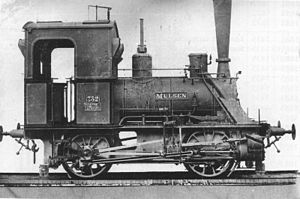Saxon VII TOV
| VII TOV | |
|---|---|

|
|
| Number: | 4th |
| Numbering: | 732, 733, 752, 753 1413-1416 (from 1892) |
| Manufacturer: | Saxon machine factory , Chemnitz |
| Commissioning: | 1885, 1887 |
| Retirement: | until 1923 |
| Type : | B n2vt |
| Length over buffers: | 6,744 mm |
| Driving wheel diameter: | 1,230 mm |
| Top speed: | 45 km / h |
| Boiler overpressure: | 12 bar |
| Piston stroke: | 400 mm |
| HD cylinder diameter : | 270 mm |
| LP cylinder diameter: | 415 mm |
| Grate area: | 0.40 m² |
| Evaporation heating surface: | 26.5 m² |
| indicated performance: | k. A. |
| mean axle mass: | 9.6 t |
| Friction mass | 19.2 t |
| Service mass : | 19.2 t |
| Brake design : | various |
| 1492 A / B (different data) | |
|---|---|
| Type : | B + B n4vt |
| Length over buffers: | 12,810 mm |
| Friction mass : | 38.4 t |
| Brake design : | k. A. |
As Genus VII TO and VII TO designated Royal Saxon State Railways zweifachgekuppelte tank locomotives for the secondary rail .
history
The small machines, also known as omnibus locomotives, were intended for use in times of low traffic for a railcar-like operation with one-man crew. The Sächsische Maschinenfabrik, formerly Hartmann, delivered two of these two-axle wet steam tank locomotives in 1885 and 1887, which were designated as H VII TO.
In the years 1890/91 they received a compound engine through conversion . Accordingly, the generic symbol was changed to H VII TOV (from 1896 only VII TOV).
The locomotives were taken out of service until 1923, so that what was now the Deutsche Reichsbahn no longer issued any new numbers.
- Double locomotive 1492 A / B
The locomotives 1413 and 1414 were combined into a double locomotive with the number 1492 A / B in 1920. The loner was classified in the category XVI TV and was retired in 1923.
The idea for such double locomotives, which were unique in Germany - apart from a few narrow-gauge locomotives for the Heeresfeldbahn - may go back to the (English) Fairlie locomotives, of which the Kgl. Saxon State Railways had procured two types of type II K and IM for their narrow-gauge railways.
technical features
The locomotives had a very small Crampton boiler with a regulator dome and an external Allan control. Originally they only had a throw lever brake, later the reel for the little lever brake or a Westinghouse air brake were partially retrofitted.
During the conversion to a compound engine in 1890, the diameter of the left steam cylinder was increased to 415 mm (low-pressure cylinder). The right cylinder kept its original size (high pressure cylinder).
